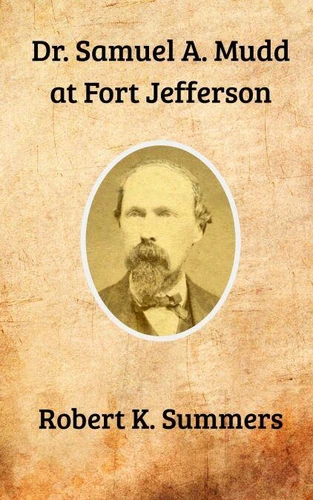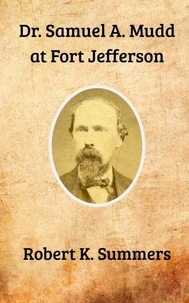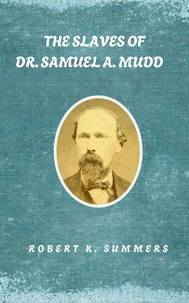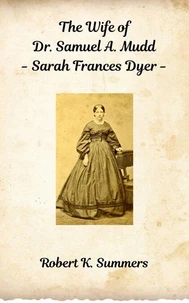- Accueil /
- Robert K. Summers
Robert K. Summers

Dernière sortie
Dr. Samuel A. Mudd at Fort Jefferson
Dr. Samuel A. Mudd was one of the eight persons convicted in the 1865 Lincoln assassination trial. Four of them were involved in helping the assassin John Wilkes Booth plan and carry out the assassination, and were executed. Dr. Mudd and the other three were not involved in the assassination, but were either involved with Booth in an earlier plot against Lincoln, or thought to have helped Booth escape capture after the assassination.
They were incarcerated at Fort Jefferson, a Union Army military prison located on a remote island in the Gulf of Mexico, a thousand miles from Dr. Mudd's home in Maryland. Fort Jefferson housed an assortment of military criminals, including deserters, murderers, and thieves. It was a rough crowd. A standing order said:"If a prisoner refuses to obey orders the sentinel must shoot him, and then use his bayonet, at the same time calling for the guard."Shortly after his arrival, Dr.
Mudd attempted to escape by stowing away on a visiting supply ship but was caught and confined in the fort's dungeon for almost four months. In 1867, Fort Jefferson faced a devastating yellow fever outbreak that claimed many lives. Amid the crisis, Dr. Mudd and a civilian doctor from Key West cared for the sick and dying, including the prison guards. When the epidemic was over, 300 soldiers signed a petition asking President Andrew Johnson to pardon Dr.
Mudd, citing his heroic service during the epidemic. Johnson granted the pardon shortly before he left office, saying:"I am satisfied that the guilt found by the said judgment against Samuel A. Mudd was of receiving, entertaining, harboring, and concealing John Wilkes Booth and David E. Herold, with the intent to aid, abet and assist them in escaping from justice after the assassination of the late President of the United States, and not of any other or greater participation or complicity in said abominable crime."After his release, Dr.
Mudd returned home to his family in Maryland, resuming his work as a country doctor and farmer until his death in 1883. Though his actions following Lincoln's assassination remain controversial, Dr. Mudd's heroic work during the yellow fever epidemic, when he himself almost died, redeemed him in the eyes of many.
They were incarcerated at Fort Jefferson, a Union Army military prison located on a remote island in the Gulf of Mexico, a thousand miles from Dr. Mudd's home in Maryland. Fort Jefferson housed an assortment of military criminals, including deserters, murderers, and thieves. It was a rough crowd. A standing order said:"If a prisoner refuses to obey orders the sentinel must shoot him, and then use his bayonet, at the same time calling for the guard."Shortly after his arrival, Dr.
Mudd attempted to escape by stowing away on a visiting supply ship but was caught and confined in the fort's dungeon for almost four months. In 1867, Fort Jefferson faced a devastating yellow fever outbreak that claimed many lives. Amid the crisis, Dr. Mudd and a civilian doctor from Key West cared for the sick and dying, including the prison guards. When the epidemic was over, 300 soldiers signed a petition asking President Andrew Johnson to pardon Dr.
Mudd, citing his heroic service during the epidemic. Johnson granted the pardon shortly before he left office, saying:"I am satisfied that the guilt found by the said judgment against Samuel A. Mudd was of receiving, entertaining, harboring, and concealing John Wilkes Booth and David E. Herold, with the intent to aid, abet and assist them in escaping from justice after the assassination of the late President of the United States, and not of any other or greater participation or complicity in said abominable crime."After his release, Dr.
Mudd returned home to his family in Maryland, resuming his work as a country doctor and farmer until his death in 1883. Though his actions following Lincoln's assassination remain controversial, Dr. Mudd's heroic work during the yellow fever epidemic, when he himself almost died, redeemed him in the eyes of many.
Dr. Samuel A. Mudd was one of the eight persons convicted in the 1865 Lincoln assassination trial. Four of them were involved in helping the assassin John Wilkes Booth plan and carry out the assassination, and were executed. Dr. Mudd and the other three were not involved in the assassination, but were either involved with Booth in an earlier plot against Lincoln, or thought to have helped Booth escape capture after the assassination.
They were incarcerated at Fort Jefferson, a Union Army military prison located on a remote island in the Gulf of Mexico, a thousand miles from Dr. Mudd's home in Maryland. Fort Jefferson housed an assortment of military criminals, including deserters, murderers, and thieves. It was a rough crowd. A standing order said:"If a prisoner refuses to obey orders the sentinel must shoot him, and then use his bayonet, at the same time calling for the guard."Shortly after his arrival, Dr.
Mudd attempted to escape by stowing away on a visiting supply ship but was caught and confined in the fort's dungeon for almost four months. In 1867, Fort Jefferson faced a devastating yellow fever outbreak that claimed many lives. Amid the crisis, Dr. Mudd and a civilian doctor from Key West cared for the sick and dying, including the prison guards. When the epidemic was over, 300 soldiers signed a petition asking President Andrew Johnson to pardon Dr.
Mudd, citing his heroic service during the epidemic. Johnson granted the pardon shortly before he left office, saying:"I am satisfied that the guilt found by the said judgment against Samuel A. Mudd was of receiving, entertaining, harboring, and concealing John Wilkes Booth and David E. Herold, with the intent to aid, abet and assist them in escaping from justice after the assassination of the late President of the United States, and not of any other or greater participation or complicity in said abominable crime."After his release, Dr.
Mudd returned home to his family in Maryland, resuming his work as a country doctor and farmer until his death in 1883. Though his actions following Lincoln's assassination remain controversial, Dr. Mudd's heroic work during the yellow fever epidemic, when he himself almost died, redeemed him in the eyes of many.
They were incarcerated at Fort Jefferson, a Union Army military prison located on a remote island in the Gulf of Mexico, a thousand miles from Dr. Mudd's home in Maryland. Fort Jefferson housed an assortment of military criminals, including deserters, murderers, and thieves. It was a rough crowd. A standing order said:"If a prisoner refuses to obey orders the sentinel must shoot him, and then use his bayonet, at the same time calling for the guard."Shortly after his arrival, Dr.
Mudd attempted to escape by stowing away on a visiting supply ship but was caught and confined in the fort's dungeon for almost four months. In 1867, Fort Jefferson faced a devastating yellow fever outbreak that claimed many lives. Amid the crisis, Dr. Mudd and a civilian doctor from Key West cared for the sick and dying, including the prison guards. When the epidemic was over, 300 soldiers signed a petition asking President Andrew Johnson to pardon Dr.
Mudd, citing his heroic service during the epidemic. Johnson granted the pardon shortly before he left office, saying:"I am satisfied that the guilt found by the said judgment against Samuel A. Mudd was of receiving, entertaining, harboring, and concealing John Wilkes Booth and David E. Herold, with the intent to aid, abet and assist them in escaping from justice after the assassination of the late President of the United States, and not of any other or greater participation or complicity in said abominable crime."After his release, Dr.
Mudd returned home to his family in Maryland, resuming his work as a country doctor and farmer until his death in 1883. Though his actions following Lincoln's assassination remain controversial, Dr. Mudd's heroic work during the yellow fever epidemic, when he himself almost died, redeemed him in the eyes of many.




